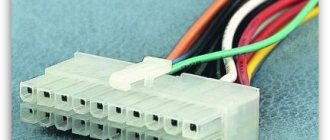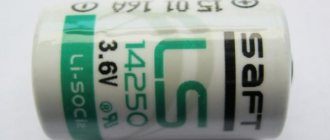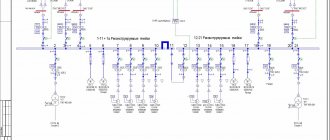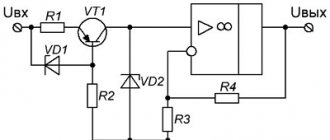In accordance with the PUE (clause 1.2.18-20), with regard to ensuring the reliability of power supply, power receivers are divided into three categories.
Category 1 power receivers are those devices, the interruption of power supply to which can entail danger to human life, significant damage to the national economy, damage to expensive capital equipment, mass defects of products, disruption of a complex technological process, disruption of the functioning of particularly important elements of public utilities. The power supply for such electrical receivers must be provided from two independent sources; a break is allowed only for the period of automatic power restoration.
Classification of electrical receivers to ensure reliability of power supply
With regard to ensuring the reliability of power supply, power receivers are divided into the following three categories:
Category I electrical receivers are electrical receivers, the interruption of power supply to which may entail: danger to human life, significant damage to the national economy, damage to expensive capital equipment, mass defects of products, disruption of a complex technological process, disruption of the functioning of particularly important elements of public utilities.
From category I electrical receivers, a special group of electrical receivers is distinguished, the uninterrupted operation of which is necessary for an accident-free shutdown of production in order to prevent a threat to human life, explosions, fires and damage to expensive capital equipment.
Category II power consumers are power consumers whose power supply interruption leads to a massive undersupply of products, massive downtime of workers, machinery and industrial transport, disruption of the normal activities of a significant number of urban and rural residents.
Electrical receivers of category III - all other electrical consumers that do not fit the definitions of categories I and II. These are receivers for auxiliary workshops, non-serial production of products, etc.
Category I power receivers must be provided with electricity from two independent, mutually redundant power sources, and an interruption in their power supply in the event of a power failure from one of the power sources can be allowed only for the duration of automatic power restoration. To supply power to a special group of category I electrical receivers, additional power must be provided from a third independent, mutually redundant power source.
Elements of an electrical circuit that convert various types of energy into electromagnetic energy, consumed and stored in other elements, are called sources (generators) or active elements
chains.
Elements that irreversibly consume electromagnetic energy or accumulate it are passive elements.
The simplest circuit elements connected to the remaining two terminals are called
two-terminal networks
.
Passive elements. Irreversible energy consumption occurs in the resistive element R
(Table 1.1, line 1).
With consistent reading directions of current and voltage indicated in the figure, the relationship between them is expressed by Ohm's law
:
uR = Ri
, where
R
is the resistance of the element - a parameter that determines the intensity of energy consumption.
iR = Gu
is often used , where
G =
1/
R
is the conductivity of the element. The power and energy consumed by the resistor are positive:
Energy accumulation in a magnetic field is carried out in the inductive element L
(Table 1.1, line 2), in which when current
i
, changing over time, the flux linkage changes and an emf is induced ( ).
Parameter L
-
inductance
- determines the intensity of energy accumulation.
To overcome the emf e,
voltage must be applied to the terminals of the element from external sources. The inductive element consumes energy at positive values, when the magnetic field energy increases, and releases it at.
The process of energy accumulation in an electric field is carried out in a capacitive element C
(Table 1.1, line 3), the current of which
i = dq/dt
is determined by the rate of change of charge on the plates of the element, related to the voltage between the plates by the expression
q
=
CuC
, where
C
is
the capacitance
of the element, which determines the intensity of energy accumulation. The element consumes energy at and releases it at .
Dependencies _
(
i
) resistor, Y (
i
) inductive coil,
q
(
u
) capacitor -
the characteristics of the elements
are generally nonlinear.
Elements with such characteristics are called nonlinear
.
When the corresponding characteristic is linear, the parameters R
,
L
or
C
are constant, and the elements are called
linear
.
The relationships between voltage and current of linear inductive and capacitive elements are shown in Table. 1.1. A circuit composed entirely of linear elements is called linear
.
The differential or algebraic equations that describe it are linear. The energy accumulated in linear elements L
and
C
is given by the expressions given in Table. 1.1.
Table 1.1
| element | scheme | voltage | current | energy |
| resistive | u = Ri | i = Gu | ||
| inductive | ||||
| capacitive |
Active elements . Real energy sources often operate in one of the following modes: 1) over the entire range of permissible current values, the voltage at the terminals depends little on the flowing current; 2) on the contrary, in the operating range the current generated by the source. depends little on the voltage at its terminals.
| Rice. 1.2 | Idealization of the properties of sources of the 1st type leads to an EMF source - an element whose terminal voltage does not depend on the current flowing through this source. The arrow inside the circle, schematically depicting the EMF source (Fig. 1.2, a ), shows the direction of action of the EMF - the direction in which, due to energy conversion, positive charges move inside the source. As a result, voltage arises outside the source between its terminals. |
For the one shown by the arrow in Fig. 1.2, a
direction of voltage reading we have
u
=
e
.
The accepted direction of reference u
corresponds to the direction of the lines of electric field strength arising in the space surrounding the source.
If a passive element is connected to the source terminals, then this electric field will cause the movement of positive charges in the external circuit - electric current i
in the direction of the arrow.
Idealization of the properties of a type 2 source - this is a current source
(Fig. 1.2,
b
), the current
J
does not depend on the voltage
u
at its terminals.
To describe the properties of components of electronic circuits (for example, transistors), controlled (dependent) sources
, the parameters of which depend on the voltages or currents in other parts of the electrical circuit under consideration. There are four types of managed sources:
| Rice. 1.3 | 1) A voltage controlled voltage source (VNCN), or a voltage amplifier, the EMF of which is proportional to the voltage uab between points a and b of the circuit (Fig. 1.3, a ). Another way to diagram a voltage amplifier is shown in Fig. 1.4, a . It is equivalent to rice. 1.3, and assumes that the current in the input branch |
amplifier i
in = 0 - the input resistance of the amplifier is infinite, and the output voltage
i
out =
ku
in does not depend on the connected load - the output resistance is zero.
2) Voltage-controlled current source (VTUN), the current of which is proportional to the voltage uab
in another section (Fig. 1.3,
b
).
3) Voltage source controlled by current (INUT), the EMF of which is proportional to the current iab
in any section (Fig. 1.3,
c
).
4) A current source controlled by current (ITUT), or a current amplifier, the current J
is proportional to the current of another section of the circuit
iab
(Fig. 1.3,
d
).
A type of voltage amplifier is an operational amplifier (op-amp). It amplifies the voltage difference uab
=
ua
–
ub
attached to the input nodes (Fig. 1.4,
b
).
Rice. 1.4
Input b
, the voltage polarity of which is changed by the amplifier, is called inverting, input
a
is called non-inverting.
The output voltage of such an amplifier is equal to uout
=
k
(
ua
–
ub
).
Given that the gain k
of operational amplifiers reaches values of 104 - 106, an idealization associated with the assumption of an infinite value of the operational amplifier gain is often adopted.
However, since at k
® ¥ the output voltage remains limited, the adopted idealization leads to the requirement that the voltages of the input nodes
a
and
b
.
Thus, for an ideal op-amp with k
= ¥ we have the following conditions:
ua
=
ub
;
ia
= 0;
ib
= 0.
The types of elements considered are idealized models of components of electrical circuits - a resistor, an inductor, a capacitor, an energy source. With their help, you can also display secondary, or, as they sometimes say, “parasitic” phenomena that occur in other components of real electromagnetic devices and in the space surrounding them. A more complete model can be built by connecting individual elements into the so-called equivalent circuit of the device in question.
Note that the introduced set of three ideal passive elements, as well as independent and controlled sources, allows us to create circuit models of almost any electromagnetic devices and devices that we encounter in practice
5. ANSWERED Topological concepts of the theory of electrical circuits: node, branch, circuit, main circuits. Kirchhoff's laws.
Electrical circuit topology
An electrical circuit is characterized by the set of elements of which it consists and the method of connecting them. The connection of the elements of an electrical circuit is clearly shown by its diagram. Let us consider, for example, two electrical circuits (Fig. 1, 2), introducing the concept of branch and node.
| Fig.1 | Fig.2 |
A branch is a section of a circuit flowing around the same current.
A node is a junction of three or more branches.
The presented circuits are different in both form and purpose, but each of the indicated circuits contains 6 branches and 4 nodes, identically connected. Thus, in the sense of the geometry (topology) of branch connections, these circuits are identical.
The topological (geometric) properties of an electrical circuit do not depend on the type and properties of the elements that make up the branch. Therefore, it is advisable to depict each branch of the electrical circuit diagram as a line segment. If each branch of the circuits in Fig. Replace 1 and 2 with a line segment, you get the geometric figure shown in Fig. 3.
A conventional representation of a circuit in which each branch is replaced by a line segment is called an electrical circuit graph . It should be remembered that branches can consist of any elements, in turn connected in different ways.
The line segment corresponding to a branch of the diagram is called a graph branch . The boundary points of a graph branch are called graph nodes . The branches of the graph can be given a specific orientation, indicated by an arrow. A graph in which all branches are oriented is called directed .
A subgraph of a graph is a part of the graph, i.e. it can be one branch or one isolated node of the graph, as well as any set of branches and nodes contained in the graph.
In the theory of electrical circuits, the following subgraphs are important:
1. A path is an ordered sequence of branches in which every two adjacent branches have a common node, and any branch and any node occur only once on this path. For example, in the diagram in Fig. 3 branches 2-6-5; 4-5; 3-6-4; 1 form paths between the same pair of nodes 1
and
3
. Thus, a path is a set of branches traversed continuously.
2. A contour is a closed path in which one of the nodes is the starting and ending node of the path. For example, for the graph in Fig. 3, you can determine the contours formed by branches 2-4-6; 3-5-6; 2-3-5-4 . If there is a connection between any pair of nodes in a graph, then the graph is called connected.
3. A tree is a connected subgraph containing all the nodes of the graph, but not a single contour. Examples of trees for the graph in Fig. 3 can serve as figures in Fig. 4.
Fig.4
4. Communication branches (tree additions) are branches of the graph that complete the tree to the original graph.
If the graph contains m
nodes and
n
branches, then the number of branches of any tree, and the number of branches of a graph connection.
5. A graph section is a set of branches, the removal of which divides the graph into two isolated subgraphs, one of which, in particular, can be a separate node.
The section can be visually depicted as a trace of some closed surface cutting the corresponding branches. Examples of such surfaces are for our graph in Fig. 3 S1
and
S2
.
In this case, we obtain, respectively, sections formed by branches 6-4-5
and
6-2-1-5 .
The concept of a tree is associated with the concepts of main contours and sections:
- main circuit - a circuit consisting of tree branches and only one communication branch;
- main section - a section consisting of link branches and only one tree branch.
Topological matrices
It is difficult to assign a circuit topology to a computer with a pattern, since there are no effective pattern recognition programs. Therefore, the topology of the circuit is entered into the computer in the form of matrices, which are called topological matrices . There are three such matrices: nodal matrix, contour matrix and section matrix.
1. Nodal matrix (connection matrix) is a table of coefficients of equations compiled according to Kirchhoff’s first law. The rows of this matrix correspond to the nodes, and the columns correspond to the branches of the circuit.
For the graph in Fig. 3 we have the number of nodes m=4
and number of branches
n=6.
Then we write the matrix
AN , assuming that the matrix element ( i
is the row number;
j
is the column number) is equal to
1
if branch
j
is connected to node
i
and oriented away from it,
-1
if oriented towards it, and
0
if branch
j
is not connected to node
i
. Orienting the branches of the graph in Fig. 3, we get
.This matrix AN is written for all four nodes and is called indefinite. It should be noted that the sum of the elements of the columns of the matrix AN is always equal to zero, since each column contains one element +1
and one element
is -1
, the rest are zeros.
Usually, during calculations, one (any) is grounded. Then we arrive at the nodal matrix A (reduced matrix), which can be obtained from the matrix AN by deleting any of its rows. For example, when crossing out the line “4” we get
The number of rows of matrix A is equal to the number of independent equations for nodes, i.e. the number of equations written for an electrical circuit according to Kirchhoff's first law. So, having introduced the concept of a nodal matrix A , let's move on to Kirchhoff's first law.
Kirchhoff's first law
Usually, Kirchhoff's first law is written for the nodes of a circuit, but, strictly speaking, it is valid not only for nodes, but also for any closed surface, i.e. the ratio is valid
| (1) |
where is the current density vector; — normal to the area dS
closed surface
S.
Kirchhoff's first law is also valid for any section. In particular, for section S2
graph in Fig. 3, assuming that the numbering and directions of currents in the branches correspond to the numbering and chosen orientation of the graph branches, we can write
.
Since in a particular case the branches of the section converge at a node, Kirchhoff’s first law is also valid for it. For now, we will apply Kirchhoff’s first law for nodes, which can be written mathematically as:
| (2) |
those. the algebraic sum of the currents of the branches connected into a node is equal to zero.
In this case, when calculating, equations according to Kirchhoff’s first law are written for (m-1)
nodes, since when writing equations for all
m
nodes, one (any) of them will be linearly dependent on the others, i.e. does not provide additional information.
Let us introduce the columnar matrix of branch currents
| I= |
Then Kirchhoff's first law in matrix form has the form:
| AI=O | (3) |
– where O is the zero column matrix. A is taken as a nodal matrix ,
and not
AN , because taking into account the above, equations according to Kirchhoff’s first law are written for (m-1)
nodes.
As an example, let us write for the circuit in Fig. 3
From here we get for the first node
,
which is what should be the case.
2. Contour matrix (contour matrix) is a table of coefficients of equations compiled according to Kirchhoff’s second law. Rows of contour matrix B
correspond to the contours, and the columns correspond to the branches of the circuit.
bij element
matrix
B is equal to 1
if branch
j
is included in contour
i
and its orientation coincides with the direction of traversal of the contour,
-1
if it does not coincide with the direction of traversal of the contour, and
0
if branch
j
is not included in contour
i.
Matrix B ,
written for the main contours is called
the matrix of main contours . In this case, the direction of the connection branch of this circuit is taken as the direction of bypassing the circuit. Having selected in our example (see Fig. 5) the tree formed by branches 2-1-4 , we write down the coefficients for matrix
B. .
Let us now move on to Kirchhoff's second law.
Voltage in a certain section of an electrical circuit means the potential difference between the extreme points of this section, i.e.
| (4) |
Let's sum up the voltages on the branches of a certain circuit:
Since when going around the circuit, the potential of each i
-th point occurs twice, once with “+”, and the second with “-”, then the total sum is zero.
Thus, Kirchhoff's second law is written mathematically as:
| (5) |
- and the following formulation takes place: the algebraic sum of the voltages at the terminals of the branches (elements) of the circuit is equal to zero. In this case, when calculating circuits using Kirchhoff’s laws, independent equations are written according to Kirchhoff’s second law, i.e. equations written for contours, each of which differs from the others in at least one branch. The meaning of the topological concept of “tree”: a tree allows you to form independent contours and sections and, therefore, form independent equations according to Kirchhoff’s laws. Thus, taking into account (m-1)
equations compiled according to Kirchhoff’s first law, we obtain a system of equations that is equal to the number of branches of the circuit and, therefore, the currents in them are unique.
Let us introduce the columnar matrix of branch voltages
| U= |
Then Kirchhoff's second law in matrix form has the form
| BU = 0. | (6) |
As an example for the diagram in Fig. 5 we have
,
from where, for example, for the first circuit we get
,
which is what should be the case.
If we introduce a columnar matrix of nodal potentials
| = |
and the potential of the last node, then the matrix of voltages of branches and node potentials are related by the relation
| U=AT | (7) |
where AT
is the transposed nodal matrix.
To determine matrix B from the known matrix A = A D A C,
where
A D
is a submatrix corresponding to the branches of a certain tree,
AC
is a submatrix corresponding to the branches of a connection, the relation
B = (
-A TS A -1TD 1 ) can be used. 3. The matrix of sections is a table of coefficients of equations compiled according to Kirchhoff’s first law for sections. Its rows correspond to sections, and its columns correspond to branches of the graph.
The matrix Q compiled for the main sections is called the matrix of the main sections . The number of rows of matrix Q is equal to the number of independent sections.
Element qij
matrix
Q is equal to 1
if the branch is included in
the i
-th section and is oriented according to the direction of the section (the positive direction of the section is taken to be the direction of the tree branch included in it),
-1
if it is oriented opposite to the direction of the section, and
0
if branch
j
is not included in
i
-th section.
As an example, let's create a matrix Q of main sections for the graph in Fig. 5. When indicated in Fig. We have 5 branch orientations
In conclusion, we note that for topological matrices A , B
and
Q compiled for the same graph, the following relations hold true:
| AVT= 0; | (8) |
| QBT= 0, | (9) |
which, in particular, can be used to check the correctness of the composition of these matrices. Here 0 is the zero matrix of order .
The above equations allow us to draw an important conclusion: knowing one of the topological matrices, you can reconstruct the rest from its structure.
Literature
1. Theoretical foundations of electrical engineering. T.1. Fundamentals of the theory of linear circuits./Ed. P.A.Ionkina. Textbook for electrical engineering. universities 2nd edition, revised. and additional –M.: Higher. school, 1976.-544p.
2. Mathanov Kh.N. Basics of electrical circuit analysis. Linear circuits: Textbook. for electrical engineering and radio engineering specialist. 3rd ed. processed and additional –M.: Higher. school, 1990. –400 p.
3. Fundamentals of circuit theory: Textbook. for universities / G.V. Zeveke, P.A. Ionkin, A.V. Netushil, S.V. Strakhov. –5th ed., revised. –M.: Energoatomizdat, 1989. -528 p.
Test questions and tasks
1. Formulate the basic topological concepts for electrical circuits.
2. What is a nodal matrix?
3. What is a contour matrix?
4. What is a cross-section matrix?
5. The currents of the branches of a certain planar circuit satisfy the following complete system of independent equations:
.
Having reconstructed the circuit graph, compose matrices of the main contours and sections, assuming that the branches of the tree are assigned the first numbers.
Answer:
| B= | Q= |
6. Create a matrix of main contours for the graph in Fig. 3, assuming that the tree is formed by branches 2, 1 and 5
Answer:
| B= |
7. Solve problem 5 using relations (8) and (9).
6. Basic principles and theorems of electrical engineering (using the example of a direct current circuit).
7. ANSWERED Basic laws of electrical engineering (using the example of a DC circuit).
OMA'S LAW (named after the German physicist G. Ohm (1787-1854)) is a unit of electrical resistance. Designation Ohm. Ohm is the resistance of a conductor, between the ends of which a voltage of 1 V arises at a current of 1 A. The defining equation for electrical resistance is R = U / I.
Ohm's law is the basic law of electrical engineering, which cannot be dispensed with when calculating electrical circuits. The relationship between the voltage drop across a conductor, its resistance and current strength is easily remembered in the form of a triangle, at the vertices of which are the symbols U, I, R.
To Ohm's law
The most important law of electrical engineering is Ohm's law
THE JOULE-LENZ LAW (named after the English physicist J.P. Joule and the Russian physicist E.H. Lenz) is a law characterizing the thermal effect of electric current.
According to the law, the amount of heat Q (in joules) released in a conductor when a direct electric current passes through it depends on the current strength I (in amperes), the resistance of the conductor R (in ohms) and the time of its passage t (in seconds): Q = I2Rt.
The conversion of electrical energy into heat is widely used in electric furnaces and various electric heating devices. The same effect in electrical machines and devices leads to involuntary energy expenditure (energy loss and decreased efficiency). The heat causing these devices to heat up limits their load. If overloaded, the temperature rise may damage the insulation or shorten the service life of the unit.
KIRCHHOFF'S LAW (named after the German physicist G.R. Kirchhoff (1824-1887)) - two basic laws of electrical circuits. The first law establishes the relationship between the sum of currents directed to the connection node (positive) and the sum of currents directed from the node (negative).
The algebraic sum of the current strengths In converging at any branching point of the conductors (node) is equal to zero, i.e. SUMM(In)= 0. For example, for node A you can write: I1 + I2 = I3 + I4 or I1 + I2 – I3 – I4 = 0.
Current node
The second law establishes a connection between the sum of electromotive forces and the sum of voltage drops across the resistances of a closed circuit of an electrical circuit. Currents that coincide with an arbitrarily chosen direction of bypassing the circuit are considered positive, and those that do not coincide are considered negative.
Current circuit
The algebraic sum of the instantaneous values of the EMF of all voltage sources in any circuit of an electrical circuit is equal to the algebraic sum of the instantaneous values of the voltage drops across all resistances of the same circuit SUMM(En)=SUMM(InRn). By rearranging SUMM(InRn) to the left side of the equation, we obtain SUMM(En) – SUMM(InRn) = 0. The algebraic sum of the instantaneous voltage values on all elements of the closed circuit of the electrical circuit is equal to zero.
Kirchhoff's laws
THE LAW OF TOTAL CURRENT is one of the basic laws of the electromagnetic field. Establishes the relationship between magnetic force and the amount of current passing through a surface. The total current is understood as the algebraic sum of currents penetrating a surface bounded by a closed loop.
The magnetizing force along a contour is equal to the total current passing through the surface bounded by this contour. In the general case, the field strength in different sections of the magnetic line can have different values, and then the magnetizing force will be equal to the sum of the magnetizing forces of each line.
LENZ'S LAW is a basic rule that covers all cases of electromagnetic induction and allows one to determine the direction of the resulting emf. induction.
According to Lenz's law, this direction in all cases is such that the current created by the emerging emf prevents the changes that caused the appearance of the emf. induction. This law is a qualitative formulation of the law of conservation of energy as applied to electromagnetic induction.
LAW OF ELECTROMAGNETIC INDUCTION , Faraday's law is a law that establishes the relationship between magnetic and electrical phenomena. The EMF of electromagnetic induction in a circuit is numerically equal and opposite in sign to the rate of change of magnetic flux through the surface bounded by this circuit. The magnitude of the EMF field depends on the rate of change of the magnetic flux.
FARADAY'S LAWS (named after the English physicist M. Faraday (1791-1867)) are the basic laws of electrolysis.
A relationship is established between the amount of electricity passing through an electrically conductive solution (electrolyte) and the amount of substance released at the electrodes.
When passing a direct current I through the electrolyte for a second, q = It, m = kIt.
Faraday's second law: the electrochemical equivalents of elements are directly proportional to their chemical equivalents.
GILMET'S RULE - a rule that allows you to determine the direction of the magnetic field, depending on the direction of the electric current. When the translational movement of the gimlet coincides with the flowing current, the direction of rotation of its handle indicates the direction of the magnetic lines. Or, if the direction of rotation of the gimlet handle coincides with the direction of the current in the circuit, the translational movement of the gimlet indicates the direction of the magnetic lines penetrating the surface bounded by the circuit.
Gimlet rule
LEFT HAND RULE - a rule that allows you to determine the direction of the electromagnetic force. If the palm of the left hand is positioned so that the vector of magnetic induction enters it (the four extended fingers coincide with the direction of the current), then the thumb of the left hand bent at a right angle shows the direction of the electromagnetic force.
Left hand rule
RIGHT HAND RULE - a rule that allows you to determine the direction of the induced emf of electromagnetic induction. The palm of the right hand is positioned so that the magnetic lines enter it. The thumb bent at a right angle is aligned with the direction of movement of the conductor. The extended four fingers will indicate the direction of the induced emf.
8. The problem of analysis and calculation of linear electrical circuits. General principles of circuit calculation using the example of DC circuits.
9. ANSWERED The concept of equivalence. Basic equivalent transformations of a circuit section not containing energy sources.
To simplify the analysis of complex electrical circuits, individual sections that do not contain EMF, or entire passive circuits, can be replaced with one equivalent resistance. By equivalent is meant a resistance that, being included in the circuit instead of the group of resistances being replaced, does not change the distribution of currents and voltages in the rest of the circuit.
When connecting resistances in series for each of them
the same current flows, therefore, the voltage drop across the equivalent resistance must be equal to the sum of the voltage drops across the original resistances:
from here we get:
If a group of replaceable resistances is connected in parallel, then
the voltages on each of them and on the equivalent resistance are the same. The equivalence conditions will be satisfied if the current through the desired resistance is equal to the sum of the currents through the individual parallel resistances:
Using Ohm's law for a single resistance, we can write:
Finally we get:
Since the reciprocal of resistance is conductivity, introducing the notation for conductivity, we get:
When analyzing complex circuits, there are cases when part of the circuit forms a so-called resistance triangle:
The circuit is simplified if the triangle with resistances Raв, Rвс, Rса is replaced with an equivalent star with resistances Ra, Rв, Rс. Sometimes, on the contrary, the reverse transformation of a star into a triangle is necessary. Delta and star circuits are considered equivalent if, after the transformation, all currents and voltages in the remaining parts of the circuit (not affected by the transformations) remain unchanged.
Obviously, the equivalence conditions must also be met in the event of a break in the wires approaching nodes “a”, “b”, “c”. For example, if the wire leading to node “a” breaks, the resistance between points “b” and “c” in the triangle and star should be the same, i.e.:
Arguing in a similar way, we can write:
Solving the resulting system of equations for Ra, Rb and Rc, we obtain formulas for the equivalent transformation of a triangle into a star:
Solving the system relatively, we obtain formulas for converting a star into a triangle:
In the particular case when the resistances of a star or a triangle are the same, these formulas are simplified:
10. ANSWERED The concept of equivalent transformations of a circuit section containing energy sources and receivers.










